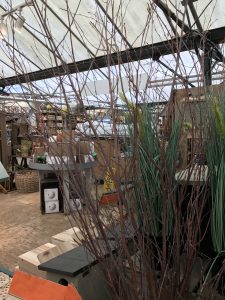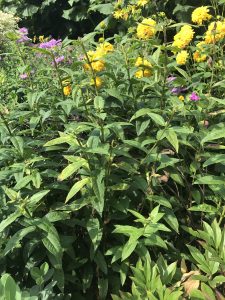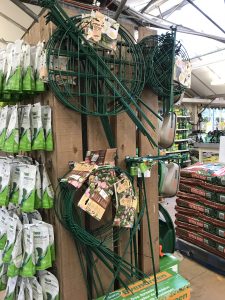What’s at stake?

I seem to have spent more time staking this August than in previous years.
The dry hot early summer followed by the deluges of the last month have led to huge bursts of growth. A lot of the staking I’d put in place in late spring proved insufficient and several plants needed more help. So this involved a couple of trips through the border, putting in supports for plants which had grown up quickly over the last few weeks, but were now in danger of being flattened by a downpour. I also had to rework a lot my previous staking. Some plants had not quite made the expected height, so either a change of support, or lowering the staking by pushing it deeper into the ground was needed. Others had bushed out so far beyond their initial boundaries that I had to take out the old and give them a whole new structure. It all took a couple of additional days of work, but was well worth it to maintain both the look of the border and keep plants thriving through the late summer. As well as looking neater, keeping plants upright and in a good shape helps them grow, and gives less chance for pests and disease to spread.
What to stake with:
There are many types of plant support available, which offer varying degrees of permanence, and which give different looks to your border. It’s worth spending a bit of time thinking about what you want.
Pea sticks
My usual favourite is to use “pea sticks”. These are top branches of trees, usually cut in early spring and often from trees that are coppiced. Birch is ideal, though Hazel is also good. Both have a flexibility and a branching structure which lend themselves to staking for herbaceous plants. Pea sticks as I use them are not just a straight pole, but a branch up to around thumb thickness at the base with feathering side branches. The side branches can give support themselves, or can be woven together from a circle of stakes around the plant, to create a cage-like structure, which the plant grows through. Willow can also be used, but as a plant it displays a determination to root which means you can end up with your supports also putting on growth.

These kind of supports don’t last from one season to the next, but are pulled up and discarded (to bonfire or compost) when the plants are cut back in autumn. It is now too late to start from scratch with woven pea stick supports. However next staking season (wait for the spring) I’ll write more about these, and you will find gardens and colleges offering courses if you doubt your ability to create good supports.

Keeping that idea of a natural look in mind, though, I have supported my border in the last few weeks with additional branches or sticks. A shorter, branched stick, tucked in by a smaller plant that has started to collapse onto its neighbour can blend in almost unnoticed. It can then provide enough support to restore structure and keep plants in place for the last month of the summer, without the border looking like it is full of metal poles or canes.
Metal
Metal supports are durable and can be reused year after year. Initially these can look unattractive, but it is surprising how quickly they are hidden once plants grow. There are a variety of options, in wire or thicker metal, including frames, rings, hoops and grids. The grid or ring style, like woven sticks, will need to have been in place in spring, before the plant grows up through it to full height.

The hoop, or half ring, is a useful and versatile support and can be very useful to add in or adjust for larger, clumping plants as the season goes on. You can use it to hold back one side of a plant, but it’s usually best to form a complete shape around the plant, and connect the hoops together with wire to form a stronger frame. These are useful for keeping back larger plants which are starting to fall over the edge of the bed, onto a path or lawn.

Canes
Canes or any straight posts are the simplest and cheaper option for plant support. I struggle to make supports with canes and string harmonious with the border. They tend to stick out as an eyesore, no matter how carefully constructed, and pointy ends can form a hazard for anyone leaning in to look at the flowers. If you do resort to canes, then the best method is to push in canes in a ring quite closely around the plant (but without causing damage) and then loop string around the canes at a couple of levels, which will support the plant by holding it into a clump and keeping the stems more upright.
Canes and poles can work wonders to prop up an enthusiastic Dahlia, and these can be supported by being tied to canes or poles as they grow. However, try to keep canes shorter than the full height of the plant. This will help to hide them in the border.
Whatever style you choose, keeping a supply of supports tucked away for use when the late Summer surge happens is invaluable.